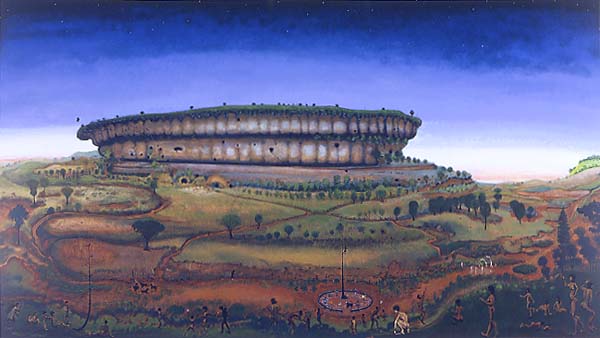
Brick Kilns," Clay Bluffs 1900 Miles above St. Louis, George Catlin, 1832
Painter/enthnographer/showman/lawyer George Catlin saw and captured a moment in culture and time--the rapidly changing/disappearing society of over 50 American Indian tribes on the cusp of westward expansion. The largest exhibit of Catlin's work in 100 years is currently at the Smithsonian's Renwick Gallery. Sanford Schwartz, in the NY Review of Books, describes the paintings wonderfully, but he doesn't quite get a handle on Catlin himself. It's work, though, with an honesty and immediacy, a pretty relevant, contemporary feeling.
 The Circus, Verne Dawson, 2001
The Circus, Verne Dawson, 2001Contemporary artist Verne Dawson's work is very much of this time. While apparently set in an idyllic pre-historic past (23,800 B.C. is the date in some Dawson's titles), they sometimes include anachronistic civilization/technologies that can induce Planet Of The Apes-style post-apocalyptic pangs. Stylistically similar yet separated by over 160 years, both bodies of work feel very much of their own times.
 Far From Heaven, Todd Haynes, 2002
Far From Heaven, Todd Haynes, 2002Todd Haynes has accomplished something similar with his latest film, Far From Heaven. He didn't simply approximate the look of Douglas Sirk's 1950's melodramas; he inhabited the entire aesthetic and moral structure of the genre to create a thoroughly original film. In Geoffrey O'Brien's Artforum article, Haynes forefronts the utter intentionality of moviemaking. "Everything about film is always artificial. You can come to something far more surprisingly real by acknowledging how much of a construct it is first. It always feels so much more false to me when you set out to be real."












